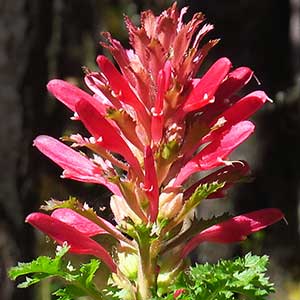Pedicularis densiflora
Pedicularis parviflora
Indian warrior, warrior's plume
pédiculaire parviflore, small-flower lousewort
basal 1–10, blade lanceolate, 30–200 x 20–70 mm, 2(or 3)-pinnatifid, margins of adjacent lobes nonoverlapping or extensively overlapping distally, 1-serrate, surfaces glabrous, hispid, or downy;
cauline 4–20, blade lanceolate, 15–250 x 5–100 mm, 2-pinnatifid, margins of adjacent lobes nonoverlapping or extensively overlapping distally, serrate, surfaces glabrous, hispid, or downy.
basal 0–2, blade elliptic, 3–7 x 2–5 mm, 1- or 2-pinnatifid, margins of adjacent lobes nonoverlapping or slightly overlapping distally, dentate, surfaces glabrous;
cauline 0–12, blade lanceolate or elliptic to deltate, 5–50 x 3–20 mm, 1- or 2-pinnatifid, margins of adjacent lobes nonoverlapping or slightly overlapping distally, serrate, surfaces glabrous.
simple, 1–5, exceeding basal leaves, each 10–50-flowered;
bracts lanceolate to trullate, 10–35 x 3–5 mm, undivided or 1-pinnatifid, proximal margins entire, distal 1- or 2-serrate, surfaces glabrous.
simple or paniculate, 1–4, exceeding basal leaves, each 3–12-flowered;
bracts deltate to trullate, 5–30 x 3–15 mm, 1- or 2-pinnatifid, margins serrate, surfaces glabrous or slightly arachnoid.
2–4 mm.
1–2.5 mm.
calyx 9–18 mm, downy to tomentose, lobes 5, triangular, 3–4 mm, apex entire, ciliate;
corolla 23–43 mm, tube dark red, purple, or orange-yellow, rarely white, 8–18 mm;
galea dark red, purple, or orange-yellow, rarely white, 15–25 mm, beakless, margins entire medially and distally, apex straight;
abaxial lip dark red, purple, or orange-yellow, rarely white, 8–15 mm.
calyx 5.5–8 mm, glabrous, lobes 2(–4), deltate, 2–3.5 mm, apex pinnatifid, sometimes 2-fid into triangular lobes, entire, glabrous;
corolla 8–16 mm, tube light pink to purple, 5–11 mm;
galea purple, 3–6 mm, beakless, margins 1-toothed medially, entire distally, apex arching slightly over abaxial lip;
abaxial lip pink to purple, sometimes purple-spotted, 2–5 mm.
= 16.
Pedicularis densiflora
Pedicularis parviflora
Scarlet corollas with an undomed, toothless galea and two- or three-pinnatifid leaves are diagnostic of Pedicularis densiflora. This species occurs in forested subalpine regions of southern Oregon, western slopes of the Sierra Nevada, and the Coast Ranges of California south to Baja California. Herbarium records indicate northern populations of P. densiflora occur at higher elevations than do more southern populations.
(Discussion copyrighted by Flora of North America; reprinted with permission.)
Pedicularis parviflora belongs to a complex of taxa [including P. parviflora var. macrodontis (Richardson) S. L. Welsh, and P. pennellii] that have traditionally been treated as species, subspecies, or varieties. Two features unite this group: a highly branched paniculate raceme and a tooth on each medial margin of the galea covered with pyriform glands on the inner surface. Lack of apical teeth sets P. parviflora apart from P. palustris and P. pennellii, which have both sets of teeth.
The distinction of Pedicularis macrodontis is not clear. With a galea that lacks apical teeth, it is clearly associated with P. parviflora, but there are no unique characters to set it apart as a distinct species; all foliar and floral features are very similar. A number of intermediate specimens were seen, suggesting a lack of reproductive barriers; treatment as a variety of P. parviflora, following S. L. Welsh (1974), may be warranted, but further research is required before recognizing it as a taxon.
(Discussion copyrighted by Flora of North America; reprinted with permission.)


